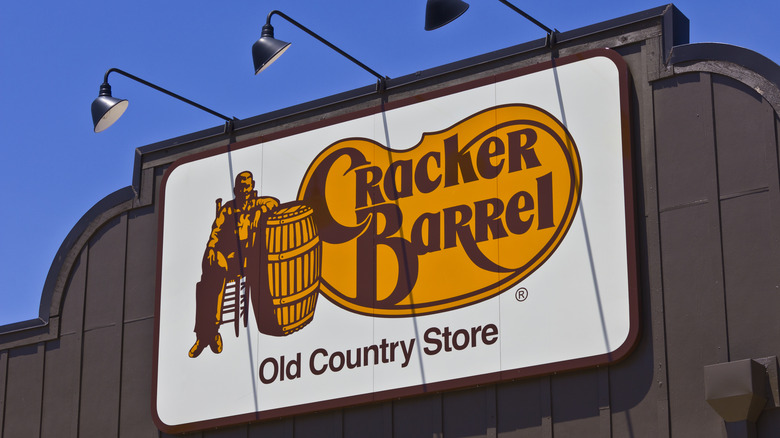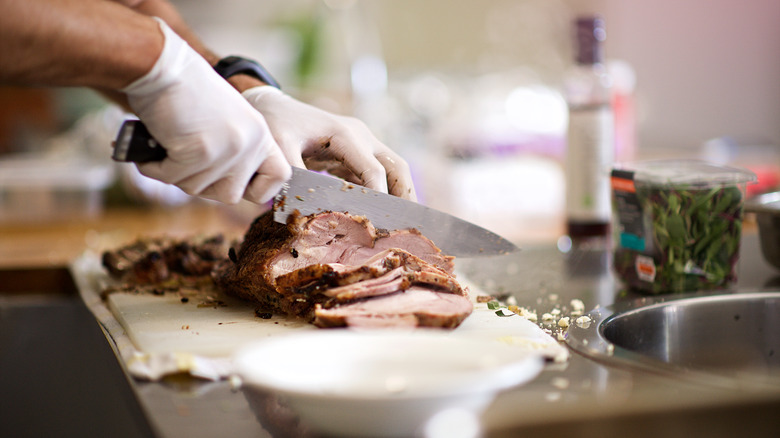The Bloody Cracker Barrel Controversy You May Have Forgotten
When pondering the absolute worst thing that could accompany your meal at a restaurant, human blood has to be at the top of the list. Unfortunately, that was the experience of Susan Mosher, according to ABC 13 Eyewitness News. Back in 2011, Mosher, a cancer survivor, was dining with her husband at a Cracker Barrel in Kingwood, Texas when she noticed a troubling sight. She identified what appeared to be bloody fingerprints on both her fries and the plate her meal was served on, which was confirmed by her server at the time.
As explained by Mosher, "I thought her eyes were going to pop out of her head. Because as soon as she seen it, she knew also what it was, and she just kept saying Oh my God, Oh my God, and took it and ran to the kitchen." Upon returning from the kitchen, the server admitted a cook had cut himself and inadvertently contaminated Mosher's food with blood. While this would be a distressing experience for any patron, Mosher was particularly concerned due to her previous bout with cancer. So concerned, in fact, she requested that Cracker Barrel compel the injured worker to undergo a blood test for her peace of mind. However, the popular southern restaurant chain was unable — or perhaps unwilling — to fulfill her request.
Cracker Barrel released a statement regarding the incident
With an incident this egregious, you'd expect a dining establishment to go above and beyond to make the situation right. And according to ABC 13 Eyewitness News, Cracker Barrel did issue a statement. However, a spokesperson for the establishment stated, "A company by law cannot compel such [blood] testing." Instead, the spokesperson urged Mosher to undergo testing on her own, for which the chain would "consider and evaluate reimbursement of medical bills," per their policies. Additionally, Mosher received an apology letter accompanied by two $50 gift cards.
As one might imagine, Mosher was in no hurry to redeem her gift cards. Instead, the beleaguered diner planned to follow up with her doctor, as well as her lawyer. As for the Cracker Barrel where the incident occurred, county health inspectors visited the establishment and issued warnings regarding safe practices at the restaurant. As far as preventing similar issues from occurring in the future, there are fortunately a few answers available to restaurants when it comes to best practices.
How should dining establishments address possible safety issues?
While annual bloodborne pathogen training is beneficial throughout numerous industries, it's only mandated for workers who have an increased risk of blood exposure (per the Occupational Safety and Health Administration). And while many restaurants implement rules about the proper procedures for handling kitchen injuries, this information is not always available to the general public. For instance, the Cracker Barrel corporate handbook states that the establishment "complies with all food and product safety laws applicable to the Company and its business," but stops short of providing details.
According to StateFoodSafety Resources, restaurants must take crucial steps when it comes to wound care strategies. First and foremost, employees are encouraged to stop working immediately upon injuring themselves. In addition to assessing the severity of the wound, the employee should also inform the manager on duty. Any food that was being handled at the time of the injury must be discarded, regardless of visible contamination, while utensils should be fully cleaned and sterilized. If the cut is minor and does not require emergency medical care, the worker should treat it using the proper first-aid practices, then bandage the wound and wear gloves to create a double barrier. If only the Kingwood Cracker Barrel followed these commonsense practices back in 2011, it could have spared a customer significant mental distress.


